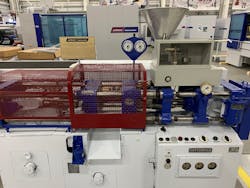2020 in review: Levitating printed parts brought magic to a news-filled year
The year 2020 will soon be behind us and there will be plenty to remember — especially the beginning of the worst pandemic in 100 years and a contentious presidential election.
Plastics Machinery Magazine published plenty of notable equipment and industry stories during the year that are worth remembering as we head into another eventful year. Here are some of them, as selected by the PMM staff.
Coolest patent
Chicago-based Boeing Co. patented a 3-D printer that uses sound waves to levitate and spatially orient the part that it is printing. The patent application describes an array of acoustic radiators and corresponding acoustic reflectors, arranged so that together they create a standing wave pattern with a node that has a sound pressure force substantially equal to the force of gravity, sufficient to levitate a part within the node.
The patent overcomes common problems of standard 3-D printing methods, including the need for a platform or support material to stabilize a part, as well as the limited speed of a single print head.
A variation on the technology describes using magnetic fields to levitate a part and print heads that jet liquid metal instead of polymer.
A 3-D printer building a part layer by layer is mesmerizing. Watching the unattached part float and rotate as it forms will be more like magic.
https://plasticsmachinerymagazine.com/21148143
Defying conventional wisdom
One of the most interesting pieces of auxiliary equipment is a slow-speed granulator from Sweden’s Rapid Granulator. The new beside-the-press granulator series, specifically designed for reducing the size of brittle parts, is said to be quieter, generates less dust and uses less energy.
Conventional wisdom had always defined slow as 25 rpm. “Our first step was to find out why 25 rpm was the standard, and we eventually discovered it on a Japanese patent application from years ago,” a Rapid executive said. “It seemed no one ever questioned it.”
Rapid questioned the standard, and an 18-month research program determined that 15 rpm is actually better for a variety of reasons. That led to the OneCut Pro granulator series.
So faster is not always better, even if your name is Rapid.
https://plasticsmachinerymagazine.com/21115651
Most interesting person to chat with over café Américain
More than 50 years ago, JJ Graffin developed his first weigh-filling machine for liquids in his mother’s garage. It was a highly accurate, innovative machine because, unlike other machines of that era, it was unaffected by liquid temperature variations that caused fluctuations in filling cycles.
Graffin expanded Serac by developing a blow molding machine that is integrated with its filling machines; that system provides an all-in-one bottle manufacturing and filling solution to reduce customers’ transportation costs.
Graffin said he enjoys continuing to work as an engineer for the company, rather than strictly in an administrative or management capacity.
https://plasticsmachinerymagazine.com/21119593
Quote of the week
“We can’t fix dumb; we don’t warranty that.” – Bill Duff, GM of sales and marketing for Yizumi-HPM, talking about the value of knowledge and training for injection press operators in preventing mistakes that lead to expensive machine repairs.
https://plasticsmachinerymagazine.com/21156933
Iron Horse Award
Battenfeld, which was acquired by Wittmann Group in 2008, manufactured the 60-ton press which Southern Plastics & Rubber Co. in Ormond Beach, Fla., bought in 1970 as a used machine. After it was finally taken out of service, Ray Komara, the current owner of the company, donated it to Wittmann Battenfeld Inc.
The press has been refurbished and is on display at Wittmann Battenfeld’s Torrington, Conn., headquarters.
The machine ran ABS pipefittings for years, Komara said. It also ran a lot of HDPE athletic equipment such as football shoulder pads.
www.plasticsmachinerymagazine.com/21155422; www.plasticsmachinerymagazine.com/21156933
Going green saves lots of green for processor
A 19-year history of investing in alternative energy sources has saved hundreds of thousands of dollars in utility costs for Harbec Inc. The Ontario, N.Y., processor’s plant has been carbon neutral since 2013.
Harbec also follows water-neutral practices.
www.plasticsmachinerymagazine.com/21136683
Selfless response to the COVID-19 pandemic
When manufacturers worldwide struggled to produce enough personal protective equipment, extrusion machinery OEM Reifenhäuser quickly converted its pilot line to make film for PPE used in hospital coveralls. Later, it converted two of its meltblown test lines to produce nonwoven material for face masks.
The material for hospital coveralls is a mix of PP and PE.
The lines, located at Reifenhäuser’s headquarters campus in Troisdorf, Germany, are normally used for R&D and customer trials.
www.plasticsmachinerymagazine.com/21143793; www.plasticsmachinerymagazine.com/21131747
New product clears the air
The ScrubX system from Novatec captures and sanitizes airborne dust and plastic particulates that might have been exposed to airborne pathogens. Each unit provides 200 cubic feet per minute of airflow, controlling dust in up to 3,000 square feet of space. The built-in control system provides remote monitoring of filter status, particulate levels and other conditions. Mobile and stationary versions are available.



